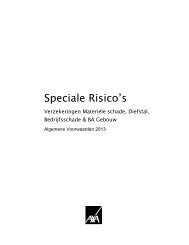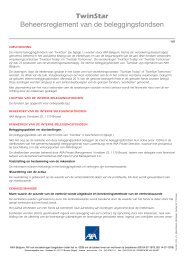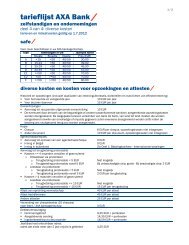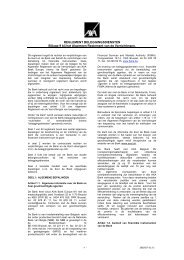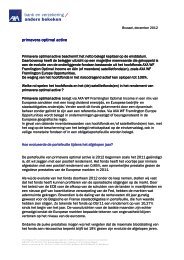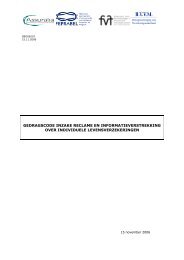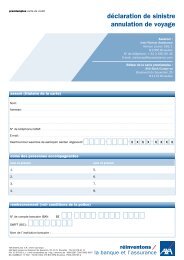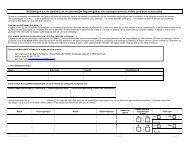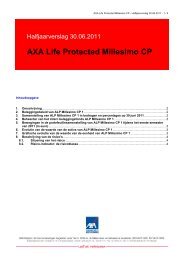- Page 1 and 2:
VISA 2012/87115-1979-0-PC L'apposit
- Page 3 and 4:
APPENDIX 46: AXA WORLD FUNDS - UNIV
- Page 5 and 6:
GLOSSARY Administrative Expenses -
- Page 7 and 8:
DIRECTORY Board of Directors: Mr Jo
- Page 9 and 10:
PART I APPENDICES RELATING TO SUB-F
- Page 11 and 12:
Hong Kong The Company is authorised
- Page 13 and 14:
Appendix 1: AXA WORLD FUNDS - FRAML
- Page 15 and 16:
One-off charges (3) Ongoing charges
- Page 17 and 18:
Date of creation of the Sub-Fund Sh
- Page 19 and 20:
Appendix 2: AXA WORLD FUNDS - FRAML
- Page 21 and 22:
One-off charges (3) Ongoing charges
- Page 23 and 24:
Sub-Fund's Auditor PricewaterhouseC
- Page 25 and 26:
Risks of global investments: Invest
- Page 27 and 28:
(6) They do not include transaction
- Page 29 and 30:
Appendix 4: AXA WORLD FUNDS - FRAML
- Page 31 and 32:
One-off charges (3) Ongoing charges
- Page 33 and 34:
Sub-Fund's Auditor PricewaterhouseC
- Page 35 and 36:
counterparty receives the underlyin
- Page 37 and 38:
One-off charges (3) Ongoing charges
- Page 39 and 40:
Tax information This Sub-Fund might
- Page 41 and 42:
Minimum subscriptions and maximum c
- Page 43 and 44:
Date of creation of the Sub-Fund Sh
- Page 45 and 46:
Name of the Sub-Fund Appendix 7: AX
- Page 47 and 48:
Ongoing charges (6) Maximum annual
- Page 49 and 50:
Date of publication August 2012 Sub
- Page 51 and 52:
Minimum subscriptions and maximum c
- Page 53 and 54:
Date of creation of the Sub-Fund Sh
- Page 55 and 56:
Appendix 9: AXA WORLD FUNDS - FRAML
- Page 57 and 58:
Ongoing charges (6) Maximum annual
- Page 59 and 60:
Date of publication August 2012 thr
- Page 61 and 62:
Investment Horizon This Sub-Fund is
- Page 63 and 64:
Date of creation of the Sub-Fund Sh
- Page 65 and 66:
Appendix 11: AXA WORLD FUNDS - FRAM
- Page 67 and 68:
Ongoing charges (6) Maximum annual
- Page 69 and 70:
Date of creation of the Sub-Fund Sh
- Page 71 and 72:
Appendix 12: AXA WORLD FUNDS - FRAM
- Page 73 and 74:
One-off charges (3) Ongoing charges
- Page 75 and 76:
Date of publication August 2012 and
- Page 77 and 78:
Investment Horizon This Sub-Fund is
- Page 79 and 80:
(6) Calculated on assets in custody
- Page 81 and 82:
Appendix 14: AXA WORLD FUNDS - FRAM
- Page 83 and 84:
One-off charges (3) Ongoing charges
- Page 85 and 86:
Date of creation of the Sub-Fund Sh
- Page 87 and 88:
Appendix 15: AXA WORLD FUNDS - FRAM
- Page 89 and 90:
One-off charges (3) Ongoing charges
- Page 91 and 92:
Date of creation of the Sub-Fund Sh
- Page 93 and 94:
Appendix 16: AXA WORLD FUNDS - FRAM
- Page 95 and 96:
Ongoing charges (5) Maximum annual
- Page 97 and 98:
Date of publication August 2012 int
- Page 99 and 100:
Risks of global investments: Invest
- Page 101 and 102:
(3) The one-off charges shown are t
- Page 103 and 104:
Holders of Shares held in Euroclear
- Page 105 and 106:
This Sub-Fund is appropriate for in
- Page 107 and 108:
Date of creation of the Sub-Fund Sh
- Page 109 and 110:
Appendix 19: AXA WORLD FUNDS - FRAM
- Page 111 and 112:
One-off charges (3) Ongoing charges
- Page 113 and 114:
Date of publication August 2012 The
- Page 115 and 116:
All these instruments may be used a
- Page 117 and 118:
Minimum initial subscription Minimu
- Page 119 and 120:
(1) Subscriptions in USD or the equ
- Page 121 and 122:
Date of publication August 2012 The
- Page 123 and 124:
Minimum subscriptions and maximum c
- Page 125 and 126:
(7) Calculated on assets in custody
- Page 127 and 128:
Name of the Sub-Fund Appendix 22: A
- Page 129 and 130:
One-off charges (3) Ongoing charges
- Page 131 and 132:
Date of publication August 2012 The
- Page 133 and 134:
Liquidity risks linked to investmen
- Page 135 and 136:
divided by the total Net Asset Valu
- Page 137 and 138:
Date of publication August 2012 The
- Page 139 and 140:
Minimum subscriptions and maximum c
- Page 141 and 142:
Date of creation of the Sub-Fund Sh
- Page 143 and 144:
Appendix 25: AXA WORLD FUNDS - FRAM
- Page 145 and 146:
Subscription, redemption, and conve
- Page 147 and 148:
Date of creation of the Sub-Fund Sh
- Page 149 and 150:
Appendix 26: AXA WORLD FUNDS - FRAM
- Page 151 and 152:
Subscription, redemption, and conve
- Page 153 and 154:
Other The AXA WORLD FUNDS - FRAMLIN
- Page 155 and 156:
and may be subject to various types
- Page 157 and 158:
(4) Conversion charges: None, excep
- Page 159 and 160:
Appendix 28: AXA WORLD FUNDS - FRAM
- Page 161 and 162: One-off charges (3) Ongoing charges
- Page 163 and 164: Sub-Fund's Auditor PricewaterhouseC
- Page 165 and 166: underlying assets. Provided it is i
- Page 167 and 168: (4) Conversion charges: None, excep
- Page 169 and 170: Appendix 30: AXA WORLD FUNDS - EURO
- Page 171 and 172: (1) (2) Subscriptions and Holding M
- Page 173 and 174: contract note. Holders of Shares he
- Page 175 and 176: (or some other designated reference
- Page 177 and 178: (5) Although no management fee will
- Page 179 and 180: Appendix 32: AXA WORLD FUNDS - EURO
- Page 181 and 182: Subscription, redemption, and conve
- Page 183 and 184: Sub-Fund's Auditor PricewaterhouseC
- Page 185 and 186: (or some other designated reference
- Page 187 and 188: (5) Although no management fee will
- Page 189 and 190: Appendix 34: AXA WORLD FUNDS - EURO
- Page 191 and 192: Minimum initial subscription Minimu
- Page 193 and 194: Date of creation of the Sub-Fund Sh
- Page 195 and 196: Appendix 35: AXA WORLD FUNDS - EURO
- Page 197 and 198: Minimum subscriptions and maximum c
- Page 199 and 200: - The Shareholder converts its Shar
- Page 201 and 202: Appendix 36: AXA WORLD FUNDS - EURO
- Page 203 and 204: Minimum subscriptions and maximum c
- Page 205 and 206: Ongoing charges (6) Maximum annual
- Page 207 and 208: Holders of Shares held in Euroclear
- Page 209 and 210: underlying assets. Provided it is i
- Page 211: (4) Conversion charges: None, excep
- Page 215 and 216: Minimum subscriptions and maximum c
- Page 217 and 218: (7) Calculated on assets in custody
- Page 219 and 220: Appendix 39: AXA WORLD FUNDS - EURO
- Page 221 and 222: Subscription, redemption, and conve
- Page 223 and 224: Date of creation of the Sub-Fund Sh
- Page 225 and 226: Appendix 40: AXA WORLD FUNDS - FRAM
- Page 227 and 228: Minimum subscriptions and maximum c
- Page 229 and 230: In case of redemption of Shares or
- Page 231 and 232: Date of publication August 2012 Sub
- Page 233 and 234: with highly rated financial institu
- Page 235 and 236: One-off charges (3) Ongoing charges
- Page 237 and 238: Date of creation of the Sub-Fund Sh
- Page 239 and 240: Appendix 42: AXA WORLD FUNDS - GLOB
- Page 241 and 242: Minimum subscriptions and maximum c
- Page 243 and 244: - the Shareholder converts its Shar
- Page 245 and 246: Appendix 43: AXA WORLD FUNDS - GLOB
- Page 247 and 248: Minimum subscriptions and maximum c
- Page 249 and 250: (6) They do not include transaction
- Page 251 and 252: Other The AXA WORLD FUNDS - GLOBAL
- Page 253 and 254: Risk Profile This Sub-Fund is mainl
- Page 255 and 256: One-off charges (3) Ongoing charges
- Page 257 and 258: Date of creation of the Sub-Fund Sh
- Page 259 and 260: Appendix 45: AXA WORLD FUNDS - GLOB
- Page 261 and 262: Minimum subscriptions and maximum c
- Page 263 and 264:
(4) Conversion charges: None, excep
- Page 265 and 266:
contract note. Holders of Shares he
- Page 267 and 268:
Special Risk Consideration Derivati
- Page 269 and 270:
One-off charges (3) Ongoing charges
- Page 271 and 272:
Date of creation of the Sub-Fund Sh
- Page 273 and 274:
Appendix 47: AXA WORLD FUNDS - US H
- Page 275 and 276:
Subscription, redemption, and conve
- Page 277 and 278:
the Company will pay dividends. Int
- Page 279 and 280:
The Reference Currency of the Sub-F
- Page 281 and 282:
Date of creation of the Sub-Fund Sh
- Page 283 and 284:
Appendix 49: AXA WORLD FUNDS - EMER
- Page 285 and 286:
Minimum subscriptions and maximum c
- Page 287 and 288:
(1) Subscriptions in EUR or the equ
- Page 289 and 290:
Sub-Fund's Depositary Sub-Fund's Au
- Page 291 and 292:
the standard terms laid down by the
- Page 293 and 294:
Ongoing charges (5) Maximum annual
- Page 295 and 296:
Date of publication August 2012 For
- Page 297 and 298:
it is in its exclusive interest, th
- Page 299 and 300:
One-off charges (3) Ongoing charges
- Page 301 and 302:
Date of creation of the Sub-Fund Sh
- Page 303 and 304:
Appendix 52: AXA WORLD FUNDS - FORC
- Page 305 and 306:
Subscription, redemption, and conve
- Page 307 and 308:
Sub-Fund's Depositary Sub-Fund's Au
- Page 309 and 310:
and market price of the said bond o
- Page 311 and 312:
Ongoing charges (5) Maximum annual
- Page 313 and 314:
Date of publication August 2012 abo
- Page 315 and 316:
Use of Derivatives: In order to ach
- Page 317 and 318:
One-off charges (3) Ongoing charges
- Page 319 and 320:
Sub-Fund's Auditor PricewaterhouseC
- Page 321 and 322:
In order to achieve its management
- Page 323 and 324:
Ongoing charges (6) Maximum annual
- Page 325 and 326:
Unless otherwise specifically reque
- Page 327 and 328:
interest, the Sub-Fund may also sel
- Page 329 and 330:
Ongoing charges (6) Maximum annual
- Page 331 and 332:
Date of creation of the Sub-Fund Sh
- Page 333 and 334:
Appendix 57: AXA WORLD FUNDS - OPTI
- Page 335 and 336:
Risk Profile This Sub-Fund is inves
- Page 337 and 338:
Ongoing charges (6) Maximum annual
- Page 339 and 340:
annually, after the end of the rele
- Page 341 and 342:
documentation for these derivatives
- Page 343 and 344:
Ongoing charges (6) Maximum annual
- Page 345 and 346:
Date of publication August 2012 thr
- Page 347 and 348:
AXA I - GENERAL INFORMATION AXA is
- Page 349 and 350:
(ii) AXA Investment Management Inc.
- Page 351 and 352:
The Equity Sub-Funds: their objecti
- Page 353 and 354:
Furthermore, there may be an imperf
- Page 355 and 356:
securities dealers and listed and u
- Page 357 and 358:
9. Risks linked to investments in s
- Page 359 and 360:
eserves amount to at least ten mill
- Page 361 and 362:
(b) Limitations on Control (15) No
- Page 363 and 364:
Furthermore, the Company may resort
- Page 365 and 366:
VIII - POOLING OF ASSETS For the pu
- Page 367 and 368:
- Class “A” Shares are for all
- Page 369 and 370:
their reasonably foreseeable sales
- Page 371 and 372:
distributor information about the s
- Page 373 and 374:
Instructions for redemptions may be
- Page 375 and 376:
Institutional Investors as well as
- Page 377 and 378:
- the "Liquidity" Sub-Funds (the po
- Page 379 and 380:
c) Rights of the Shareholders and c
- Page 381:
� the cost of preparing and filin




